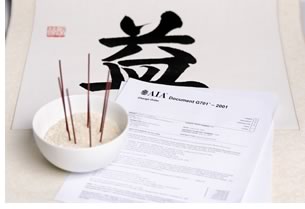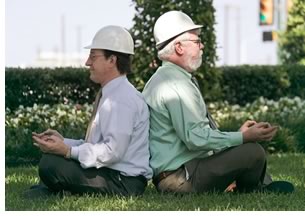

10/2005
by James B. Atkins, FAIA, and Grant A. Simpson, FAIA
 We
do not learn by experience, but by our capacity for experience.
We
do not learn by experience, but by our capacity for experience.
—Buddha Gautama, born 563 BC
Architects tend to approach construction administration with wariness and trepidation. Financial success for this phase of work is often challenging, and, at this point in the project, creative thoughts equate to money spent rather than fulfillment of design expressions. To make matters worse, almost all claims against design professionals arise during the construction phase, although the genesis of the claim may have occurred at a much earlier time.
As a result, many architects have come to view the construction phase as a time-consuming and unrewarding negotiated service. Many prefer to practice passive construction contract administration and act only when requested to do so. In fact, not too many years ago, insurance providers recommended that the designer omit this phase of services from their contract entirely, presuming that no interaction with the builders would present the architect as a smaller target and thus be the safer recourse. This proved to be a bad idea because it did nothing to reduce claims. Moreover, it denied the architect the opportunity to make informative clarifications that could possibly reduce or avoid the claim altogether.
However, since our exposure to claims is greatest during this phase of work, there is no feasible alternative other than to confront construction administration rather than avoid it. If we want a fair chance at managing our risks, we must be involved proactively during construction-phase activities to mitigate problematic issues that arise and develop an acceptable comfort level for work conformance and fulfill our contractual requirements. A reluctant spirit has no place in our construction administration mindset as problems and conflicts typically do not get better with age.
However, the construction phase can indeed be an unpleasant experience when our documents or services are being challenged and our mistakes publicized. It is easy to assume a defensive position with a “we versus they” attitude. Before we know it, we have subscribed to a bunker mentality where we make efforts to protect ourselves with documentation while we take shots at the perceived offenders, and the paper war begins.
Confrontation is required in situations where we must defend ourselves and rebut accusations, but we must be mindful that such confrontation need not be hostile or overly consuming. Valuable time and energy can be wasted in defensive documentation and trading accusations and insults.
It will be more beneficial if we discipline ourselves to approach construction administration with a peaceful attitude, somewhat like the followers of the Zen school. Much can be accomplished if we remain calm, study and develop responses to the threatening dangers, and become intuitive in our risk management actions and behavior. Zen, which originated in India and predates Buddhism, is a discipline for attaining awareness through meditation.
We can increase our effectiveness by developing a self discipline reminiscent of Keith Carradine’s character, Kwai Chang Caine in the 1970s TV series, Kung Fu, by coolly maintaining our emotions, carefully thinking things out, and acting with calm deliberation only after a reasonable recourse has been determined. Although it is a martial art, the highest level that can be reached in Shaolin Kung Fu is Zen.
This article is a lot about construction contract administration (CCA) attitudes and a little about the admirable discipline of Zen. CCA is a broad topic that could fill many volumes, but these observations will be limited to the effectiveness that can be developed through our approach to CCA along with embracing it as the professional service that it is. In the mix of these topics, we will address and offer suggestions for more effective management and loss prevention while examining ways to assess calmly and seek control of threatening circumstances, all the while striving to maintain our sanity as well as our sanctity.
 Why me?
Why me?
Accept the anxieties and difficulties of this life.
—Zen Master Kyong Ho
There is a tendency by some architects to ask, why me? CCA is not emphasized in many architecture schools. Anyway, the contractors are the ones who are supposed to know how to build the building. We didn’t spend all that time in school to wear work boots and act like contractors; we studied to be architects!
It is true that the technical aspects of our practice are not as celebrated in architecture school as is design. Frank Lloyd Wright and Ayn Rand’s character, Howard Roark in The Fountainhead, exude the image of what many think an architect is supposed to be. Technical skills simply do not hold the glamour of an artiste creating iconic designs. But the reality is that architects are judged in the courts more on technical ability, and claims against architects are primarily aimed at their products of service, their technical documents, or their actions. Since almost all claims arise during the construction phase and are usually focused on the documents, architects must embrace and interact with this part of the work.
To understand fully why architects need to practice proactive construction administration, a review of AIA Document A201-1997, General Conditions of the Contract for Construction, may help. Architects are required in Section 4.2.2 to visit the site and:
“. . . determine in general if the Work is being performed in a manner indicating that the Work, when fully completed, will be in accordance with the Contract Documents.”
Additionally, A201-1997, section 4.2.9, states:
“The Architect will conduct inspections to determine the date or dates of Substantial Completion and the date of final completion . . . ”
CCA activities essentially become governed by the desired final result, as will be certified by the architect in AIA document G704-2000, Certificate of Substantial Completion. This certificate is a document that carries significant legal implications. The gravity of this inspection and certification is evidenced by the lead-off language in the certificate:
”The Work performed under this Contract has been reviewed and found, to the Architect’s best knowledge, information and belief, to be substantially complete.”
The certificate then goes on to require that the architect attach a list of any incomplete or defective work, along with a cost estimate to correct the incomplete or defective work. Though often overlooked as a prior accord, this list should include any owner-accepted nonconforming work.
The Certificate of Substantial Completion represents that you, in your capacity as the architect, have fulfilled your contractual responsibilities for determining substantial work conformance. If you certify substantial completion when it is not, or if you fail to qualify and list owner-accepted nonconforming work or any known defective work on the certificate, you could have problems down the road.
The question is sometimes argued as to whether architects should be responsible for defective work of which they are not aware. This topic is best discussed in the context of the standard of care to which the architect should have conformed. The standard of care may be evaluated by how difficult the information would have been to obtain.
For example
Improperly installed brick ledge flashing is allowing water to leak into
the second floor of a building, damaging the second floor and the floor
below. Brick ledge flashing is typically concealed work, and some defective
work could have been covered without having been directly observed
by the architect. If the leaks are widespread, and the installation
of the defective flashing occurred in a timeframe spanning multiple
visits to the site by the architect and was visible without using specialized
climbing equipment, a claimant may argue that the architect had ample
opportunity to observe the defective work and determine that it would
present a future problem. On the other hand, if the leaks have occurred
in a single area, the architect may represent that the condition is
an isolated latent defect that they should not reasonably have been
expected to observe and be aware of.
 The
Architect’s Handbook of Professional Practice, Update 2003, contains
an article entitled, “Effective Project Closeouts,” which
addresses important activities related to substantial completion. It
includes a project closeout checklist and emphasizes the need to list
any nonconforming work as an exception to the certification. All projects
incorporate some measure of nonconforming work, and unless significant
conditions are noted, the certificate could be looked upon as a representation
that nothing significant is wrong.
The
Architect’s Handbook of Professional Practice, Update 2003, contains
an article entitled, “Effective Project Closeouts,” which
addresses important activities related to substantial completion. It
includes a project closeout checklist and emphasizes the need to list
any nonconforming work as an exception to the certification. All projects
incorporate some measure of nonconforming work, and unless significant
conditions are noted, the certificate could be looked upon as a representation
that nothing significant is wrong.
To enable the architect to fulfill the conformance determination, the architect is empowered by the owner-architect agreements to perform certain duties and responsibilities. For example, AIA document B141-1997, Standard Form of Agreement Between Owner and Architect, includes:
_ § 2.6.2.1 . . . (1) . . . to keep the Owner informed about the progress and quality of the portion of the Work completed . . . (2) To endeavor to guard the owner against defects and deficiencies in the work . . .
_ § 2.6.2.2 ... report to the Owner known deviations from the Contract Documents . . .
_ § 2.6.2.3 . . . at all times have access to the Work whenever it is in preparation or in progress.
_ § 2.6.2.5 . . . have authority to reject Work that does not conform to the Contract Documents.
_ § 2.6.3.1 . . . review and certify the amounts due the Contractor and shall issue Certificates for Payment in such amounts.
_ § 2.6.4.1 . . . review and approve or take other appropriate action upon the Contractor’s submittals such as Shop Drawings, Product Data, and Samples . . .
_ § 2.6.5.1 . . . prepare Change Orders and Construction Change Directives for the Owner’s approval and execution . . .
_ § 2.6.6.1 . . . conduct inspections to determine the date or dates of Substantial Completion and the date of Final Completion . . .
Some of these contractual requirements cannot be effectively executed from the architect’s office. Even with today’s Web cams, tablet PCs, and PDAs, the architect will go to the job site at appropriate intervals and observe the work in progress. If you decide to forego visiting the site and observing the work, and stay in your office, then you will be unable to know if the project, in general, is in accordance with the contract documents or when it is substantially complete, and you may be blamed for problems that you could have resolved or avoided had you been there.
 Why you?
Why you?
Catch not the shadow and lose the substance.
—Korean Proverb
Some architects may desire to just hire someone to do CCA or perhaps assign it to one of the team members who is not as busy, even a junior staffer. If you are the architect with responsibility for the project, it is likely that if anything really serious comes up, it will make its way to your desk anyway.
There are some very legitimate reasons why it should be you or an adequately qualified other person performing construction administration. If you are senior enough to have signed the documents, it could be your license on the line. If you are high enough up in the company, it could be your money on the line. If you were involved with the creation of the design, it could be your reputation on the line. In today’s market, it likely will not work out if we do as Frank Lloyd Wright suggested and advise the client to plant vines if there is a mistake with the building. Today, if there is a serious problem, you and your insurance policy will surely be invited to the dance.
If the preceding message has not been persuasive, we suggest that you go back and read the first two articles in this series. Article 1 is The Importance of Risk Management, and Article 2 is Risk Management Basics. They are provided for AIA members in the Risk Management Resource Center.
Proactive involvement
Technical knowledge is not enough. One must transcend techniques so
that the art becomes an artless art, growing out of the unconscious.
—Daisetsu Suzuki
So dust off that hard hat and check to be sure that you have your steel-toed boots, your protective goggles, and your orange safety vest. Women should be mindful that most construction sites prohibit skirts and heels, so do be safety conscious and follow the contractor’s OSHA safety requirements. You may also want to grab a tape recorder, a steel measuring tape, a flashlight, and a mirror for observing hard-to-get-to places.
You should be ready now to set up and run the construction phase of your project. To brush up on required construction-phase activities, take a look at The Emerging Professional’s Companion, Chapter 12, “Construction Phase, Office,” and Chapter 13, “Construction Phase, Site.” If you don’t have a copy handy, go to www.epcompanion.org. This reference material was jointly published by the AIA and NCARB to prepare interns for the ARE. It is also provided as a resource for in-house training of architectural services.
Preparation
The less effort, the faster and more powerful you will be.
—Bruce Lee
It is necessary to be prepared to be effective. The following suggestions will assist you in organizing and maintaining your management effort to your best advantage. Documentation, communication, and responsive actions are dependent upon an organized, efficient CCA process.
Use AIA documents—AIA documents have been in existence for more than 100 years and represent the standard of practice in our profession and industry. They have been written with the specific goal of balancing the interests of all the parties and have been tested in the courts. An AIA form is available for all typically required activities during the construction phase.
Organize your contract documents—Get your contract documents in order. Print out a paper copy of the version of the drawings and specifications that have been issued to the contractor. Maintain a record set of document publications in your office to use for tracking changes and contract modifications. Remember, the contractor also must maintain a set on the job site, but you should keep a control copy in your office for your own records.
Keep a journal—During this complicated phase of work, many contemporaneous activities and actions occur. If you keep a journal with you as you go about your activities, you can record critical information immediately rather than relying on your memory at a later time. Maintaining a journal has been recommended by AIA documents for many years. The Handbook of Architectural Practice, published in 1920, the first edition of what is now The Architect’s Handbook of Professional Practice, extensively addressed the use of a journal.
Establish a filing protocol—If your firm does not have a filing protocol, there is a suggested format in The Architect’s Handbook for Professional Practice, 13th edition, in Chapter 13.2, Information Management. You should have an organized method for filing all project related correspondence, both paper and electronic.
Establish project procedures—Project procedures during the construction phase are addressed in AIA document A201-1997, General Conditions of the Contract for Construction. This information is amplified in Division 1 of MasterSpec. Review these documents thoroughly and discuss specific requirements in the preconstruction conference.
Schedule project meetings, site visits, and key conferences—It helps to publish a site visit schedule and go to the site on the same day of the week at the same time. The project team will adapt more easily and will usually be more responsive. You can always drop in unannounced, or by special invitation if you feel it necessary, but stick to the schedule for meetings and conferences if practicable.
Copyright 2005 The American Institute of Architects.
All rights reserved. Home Page ![]()
![]()
 |
||
The conclusion of “Zen and the Art of Construction Administration” will appear in next week’s issue of AIArchitect This Week. In it, the authors offer a plan for taking an active yet serene role in construction contract administration. In the meantime, remember, be careful out there . . . To read the September Risk Management Best Practice article, Drawing
the Line, go to the September 5, 2005, issue. The latest installment of Risk Management Best Practices, “Drawing
the Line,” drew readers’ comments pro and con. Here
is one of each. For more information on Shaolin Kung Fu and Zen, go to the Shaolin
Kung Fu, Qigong and Zen home page. For more information on the 1970s TV series, Kung
Fu, go to the
show’s episode guide. If you would like to ask Jim and Grant a risk- or project-management question or request them to address a particular topic, contact the AIA General Counsel’s office. James B. Atkins, FAIA, is a principal with HKS Architects. He serves on the AIA Documents Committee and the AIA Risk Management Committee. Mr. Atkins is an accomplished construction administrator. Grant A. Simpson, FAIA, manages project delivery for RTKL Associates. He serves on the AIA's Practice Management Advisory Group. This article is intended for general information purposes only and does not constitute legal advice. The reader should consult with legal counsel to determine how laws, suggestions and illustrations apply to specific situations.
|
||